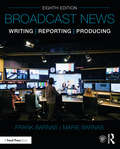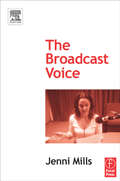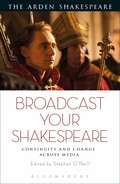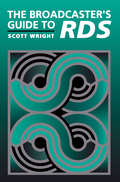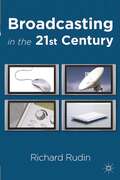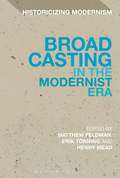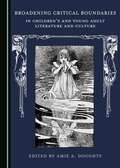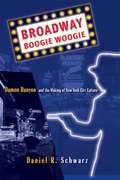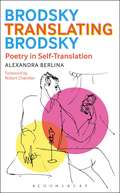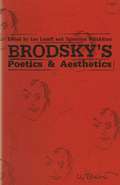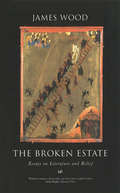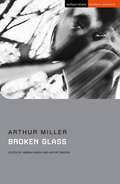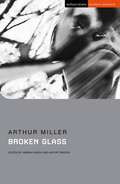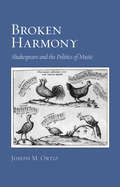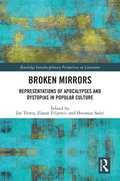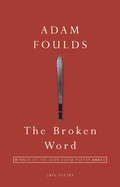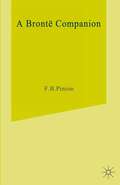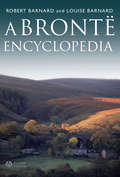- Table View
- List View
Broadcast News Writing, Reporting, and Producing
by Frank Barnas Marie BarnasNow in its eighth edition, Broadcast News Writing, Reporting, and Producing is the industry’s leading textbook covering all aspects of the three pillars of broadcast news. The book discusses the key strategies and terms of newsgathering and delivery by providing real-world, professional advice for broadcast journalists in the modern-day newsroom. New to the eighth edition is the Best Apps feature, which identifies the most productive apps used by working journalists when covering stories. The book also covers the ever increasing diversity of the journalism field and brings in new voices from professionals working in the industry to discuss these topics. Other new additions include in-depth discussions of fake news, expanded coverage of social media in the newsroom, and an overview of the latest advances in technology available to television and radio news reporters. Broadcast News Writing, Reporting, and Producing remains the best book for undergraduate students in journalism writing, producing, newsgathering, and multimedia courses. An accompanying companion website features resources to help instructors deliver online courses, including Powerpoints, Quizlets, and a sample syllabus.
The Broadcast Voice
by Jenni MillsAnyone working - or aspiring to work - as a radio or TV presenter will benefit from Jenni Mills' experience. This inspirational book and tutorial-packed CD provide unique access to the advice previously only available through her one-on-one coaching sessions. Jenni teaches how to get the best from your voice in front of the microphone through techniques and exercises designed specifically for broadcasting. She covers both the physical aspects of voice production and the mind-set needed to broadcast with authority and warmth. Audio and video clips on the accompanying CD-Rom illustrate the dos and don'ts discussed in the book as well as demonstrating voice exercises.
The Broadcast Voice
by Jenni MillsAnyone working - or aspiring to work - as a radio or TV presenter will benefit from Jenni Mills' experience. This inspirational book and tutorial-packed CD provide unique access to the advice previously only available through her one-on-one coaching sessions. Jenni teaches how to get the best from your voice in front of the microphone through techniques and exercises designed specifically for broadcasting. She covers both the physical aspects of voice production and the mind-set needed to broadcast with authority and warmth. Audio and video clips on the accompanying CD-Rom illustrate the dos and don'ts discussed in the book as well as demonstrating voice exercises.
Broadcast your Shakespeare: Continuity and Change Across Media
by Stephen O'NeillThis volume of essays contributes to current debates about Shakespeare in new media. It importantly develops the field by providing a comparativist approach to Shakespeare's dynamic media history. Contributors to Broadcast Your Shakespeare address the variety of ways Shakespeare texts have been expressed through different media and continue to be. Writing at the intersection of Shakespeare studies and media studies, these international contributors also consider the role of a particular media in producing Shakespeare's effect on us - as readers, viewers and users. The volume suggests how current analyses of new media Shakespeare have much to learn from older media, and that an awareness both of media specificity and also continuity can enhance Shakespeare pedagogy and research.
Broadcast your Shakespeare: Continuity and Change Across Media
by Stephen O'NeillThis volume of essays contributes to current debates about Shakespeare in new media. It importantly develops the field by providing a comparativist approach to Shakespeare's dynamic media history. Contributors to Broadcast Your Shakespeare address the variety of ways Shakespeare texts have been expressed through different media and continue to be. Writing at the intersection of Shakespeare studies and media studies, these international contributors also consider the role of a particular media in producing Shakespeare's effect on us - as readers, viewers and users. The volume suggests how current analyses of new media Shakespeare have much to learn from older media, and that an awareness both of media specificity and also continuity can enhance Shakespeare pedagogy and research.
The Broadcaster's Guide to RBDS
by Scott WrightThis handbook is intended to give the broadcast industry an authoritative guide to the Radio Data System (RDS), also called Radio Broadcast Data System (RBDS). Since the standard's adoption, about 700 stations have begun broadcasting RDS in the United States. There is a wide variety of encoding equipment with prices starting as low as $400, and over 30 models of RDS receivers have been introduced for cars, home receivers, portable and even PC receivers. Automobile manufacturer's such as General Motors, Ford, Audi, and Porsch now offer RDS on new vehicles. Yet despite all the support equipment in place, the FM broadcaster has been reluctant to implement and utilize this service, mainly because of a lack of understanding of what RDS can do for the station. This book finally provides the information required to understand RDS and its possibilities on a variety of levels, so that everyone involved in radio can make the most of it. Station owner, program director, salesperson, and talent alike will find the information he or she requires to maximize the possibilities of this new technology. Each feature of the system is explained in terms of its practical implementation at the station, and interviews with broadcasters currently using the system add a hands-on perspective. Scott Wright is a recognized pioneer in RDS development. As the designer of Delco Electronics' first RDS receiver, he has been extremely active in the development of the RDS standard in the US and in efforts to educate the broadcast community about its potential. He has represented Delco at the European Broadcasting Union's (EBU) RDS Forum and is currently the Chairman of the National Radio Systems Committee RBDS Subcommittee, the US standard-setting body. He is also a member of the Electronics Industries Association's (EIA) RDS Forum.
The Broadcaster's Guide to RBDS
by Scott WrightThis handbook is intended to give the broadcast industry an authoritative guide to the Radio Data System (RDS), also called Radio Broadcast Data System (RBDS). Since the standard's adoption, about 700 stations have begun broadcasting RDS in the United States. There is a wide variety of encoding equipment with prices starting as low as $400, and over 30 models of RDS receivers have been introduced for cars, home receivers, portable and even PC receivers. Automobile manufacturer's such as General Motors, Ford, Audi, and Porsch now offer RDS on new vehicles. Yet despite all the support equipment in place, the FM broadcaster has been reluctant to implement and utilize this service, mainly because of a lack of understanding of what RDS can do for the station. This book finally provides the information required to understand RDS and its possibilities on a variety of levels, so that everyone involved in radio can make the most of it. Station owner, program director, salesperson, and talent alike will find the information he or she requires to maximize the possibilities of this new technology. Each feature of the system is explained in terms of its practical implementation at the station, and interviews with broadcasters currently using the system add a hands-on perspective. Scott Wright is a recognized pioneer in RDS development. As the designer of Delco Electronics' first RDS receiver, he has been extremely active in the development of the RDS standard in the US and in efforts to educate the broadcast community about its potential. He has represented Delco at the European Broadcasting Union's (EBU) RDS Forum and is currently the Chairman of the National Radio Systems Committee RBDS Subcommittee, the US standard-setting body. He is also a member of the Electronics Industries Association's (EIA) RDS Forum.
Broadcasting in the 21st Century
by Richard RudinThe 21st century is already seeing fundamental changes in broadcasting. No longer are audiences limited to watching or listening to television and radio at the times and places dictated by the broadcasters, or on radio or TV 'sets'. Broadcasting in the21st Century demonstrates how 'traditional' television and radio is being both challenged and supported by technological developments, including convergence and social media. Drawing on interviews with industry personnel and featuring casestudies and research from many countries, including that from the UK, USA, China, India and South Africa, Richard Rudin explains not only the significance of these changes but also how many of the functions and pleasures of broadcasting that were established in the 20th century are being enhanced by new media. Opening with a substantial account of how broadcasting developed in the 20th century, the author goes on to explore how new media forms are changing audiences' pleasures, expectations and demands. Rudin's illuminating study highlights the changing relationship between audiences and broadcast output to examine a range of subjects including:- the impact of citizens' journalism- political coverage- international TV formats and news output- the continuing appeal of radio as a distinct medium- debates over bias, truth and trust in broadcasting and broadcasters. In addition, Broadcasting in the 21st Century addresses a range of broadcast forms and genres including the coverage of general elections, Reality TV and pirate radio.
Broadcasting in the Modernist Era (Historicizing Modernism)
by Matthew Feldman Henry Mead Erik TonningThe era of literary modernism coincided with a dramatic expansion of broadcast media throughout Europe, which challenged avant-garde writers with new modes of writing and provided them with a global audience for their work. Historicizing these developments and drawing on new sources for research – including the BBC archives and other important collections - Broadcasting in the Modernist Era explores the ways in which canonical writers engaged with the new media of radio and television. Considering the interlinked areas of broadcasting 'culture' and politics' in this period, the book engages the radio writing and broadcasts of such writers as Virginia Woolf, W. B. Yeats, Ezra Pound, T. S. Eliot, James Joyce, George Orwell, E. M. Forster, J. B. Priestley, Dorothy L. Sayers, David Jones and Jean-Paul Sartre. With chapters by leading international scholars, the volume's empirical-based approach aims to open up new avenues for understandings of radiogenic writing in the mass-media age.
Broadcasting in the Modernist Era (Historicizing Modernism)
by Matthew Feldman Henry Mead Erik TonningThe era of literary modernism coincided with a dramatic expansion of broadcast media throughout Europe, which challenged avant-garde writers with new modes of writing and provided them with a global audience for their work. Historicizing these developments and drawing on new sources for research – including the BBC archives and other important collections - Broadcasting in the Modernist Era explores the ways in which canonical writers engaged with the new media of radio and television. Considering the interlinked areas of broadcasting 'culture' and politics' in this period, the book engages the radio writing and broadcasts of such writers as Virginia Woolf, W. B. Yeats, Ezra Pound, T. S. Eliot, James Joyce, George Orwell, E. M. Forster, J. B. Priestley, Dorothy L. Sayers, David Jones and Jean-Paul Sartre. With chapters by leading international scholars, the volume's empirical-based approach aims to open up new avenues for understandings of radiogenic writing in the mass-media age.
Broadening Critical Boundaries In Children's And Young Adult Literature And Culture
by A. Amie DoughtyThis collection of essays explores a wealth of topics in children’s and young adult (YA) literature and culture. The contributions include an examination of the Watchbird cartoons by Munro Leaf and their attempts to teach morals and manners; an ethnographic study about the role of public youth librarians; and an exploration of the role popular video games can play in the secondary classroom. Other topics investigated here encompass the presentation of environmentalism in Hayao Miyazaki’s films, psychological analyses, and the role of race, gender, and culture in children’s and YA literature.
Broadening Jewish History (The Littman Library of Jewish Civilization)
by Todd M. EndelmanIn Broadening Jewish History Todd Endelman seeks to expand the horizons of modern Jewish historiography by focusing on ‘ordinary’ rather than exceptional Jews, arguing that what ordinary people did or felt can do more to deepen our understanding of Jewish history than what a few exceptional individuals thought and wrote. He also makes a strong case for comparative history, showing convincingly that only a comparison across national borders can identify the Germanness of German Jewish history or the Englishness of English Jewish history, and thereby reveal what is unique about each. This innovative collection of historiographical essays and case studies redefines the area under consideration and deftly restates the need for Jewish social history to counterbalance the current focus on cultural studies. The essays offer an important examination of the major trends in the writing of modern Jewish history and the assumptions that have guided historians in their narration of the Jewish past. Professor Endelman shows in particular how the two watershed events of twentieth-century Jewish history—the Holocaust and the establishment of the State of Israel—influenced Jewish historiography for decades thereafter. He also demonstrates how progressive integration into the scholarly framework of American academia has shaped both the form and the content of Jewish historical research. Each of the case studies focuses on a largely unknown figure whose career illustrates the often tortuous paths of integration and acceptance that Jews faced. Some achieved fleeting fame but many of the people who populate the volume remain altogether unknown, their histories recoverable only as statistics. In its wide-ranging analysis of trends in recent historical writing and its treatment of key themes and issues, this book is essential reading for professional historians, students, and indeed all those with an interest in Jewish history.
Broadway Boogie Woogie: Damon Runyon and the Making of New York City Culture
by D. SchwarzWhile analyzing Damon Runyon's high spirited work in terms of historical contexts, popular culture, and of the changing function of the media, Schwarz argues that in his columns and stories Runyon was an indispensable figure in creating our public images of New York City culture, including our interest in the demi-monde and underworld that explains in part the success of The Godfather films and The Sopranos . In his lively and exuberant chapters that include a panoramic view of New York City between the World Wars - with a focus on its colourful nightlife - Schwarz examines virtually every facet of Runyon's career from sports writer, daily columnist, trial reporter, and Hollywood figure to the author of the still widely-read short stories that were the source of the Broadway hit Guys and Dolls . As part of his discussion of Runyon's art and the artistry of Runyon's fiction, Schwarz skilfully examines the special language of the Broadway stories known as 'Runyonese', and explains how 'Runyonese' has become an adjective for describing flamboyant behaviour.
Brodsky Translating Brodsky: Poetry In Self-translation
by Alexandra BerlinaWinner of the Anna Balakian Prize 2016 Is poetry lost in translation, or is it perhaps the other way around? Is it found? Gained? Won? What happens when a poet decides to give his favorite Russian poems a new life in English? Are the new texts shadows, twins or doppelgangers of their originals-or are they something completely different? Does the poet resurrect himself from the death of the author by reinterpreting his own work in another language, or does he turn into a monster: a bilingual, bicultural centaur?Alexandra Berlina, herself a poetry translator and a 2012 Barnstone Translation Prize laureate, addresses these questions in this new study of Joseph Brodsky, whose Nobel-prize-winning work has never yet been discussed from this perspective.
Brodsky Translating Brodsky: Poetry In Self-translation
by Robert Chandler Alexandra BerlinaWinner of the Anna Balakian Prize 2016 Is poetry lost in translation, or is it perhaps the other way around? Is it found? Gained? Won? What happens when a poet decides to give his favorite Russian poems a new life in English? Are the new texts shadows, twins or doppelgangers of their originals-or are they something completely different? Does the poet resurrect himself from the death of the author by reinterpreting his own work in another language, or does he turn into a monster: a bilingual, bicultural centaur?Alexandra Berlina, herself a poetry translator and a 2012 Barnstone Translation Prize laureate, addresses these questions in this new study of Joseph Brodsky, whose Nobel-prize-winning work has never yet been discussed from this perspective.
The Broken Estate: Essays on Literature and Belief
by James WoodIn a series of long essays, James Wood examines the connection between literature and religious belief, in a startlingly wide group of writers. Wood re-appraises the writing of such figures as Thomas More, Jane Austen, Herman Melville, Anton Chekhov, Thomas Mann, Nikolai Gogol, Gustave Flaubert and Virginia Woolf, vigorously reading them against the grain of received opinion, and illuminatingly relating them to questions of religious and phiosophical belief. Contemporary writers, such as Martin Amis, Thomas Pynchon and George Steiner, are also discussed, with the boldness and attention to language that have made Wood such an influential and controversial figure. Writing here about his own childhood struggle to believe, Wood says that 'the child of evangelism, if he does not believe, inherits nevertheless a suspicion of indifference'. Wood brings that suspicion to bear on literature itself. The result is a unique book of criticism.
Broken Glass (Student Editions)
by Arthur Miller"It's moral vision, as well as the Miller voice, which remains as strong and unrelenting as a prophet's, that distinguish Broken Glass." - The New York Times When Sylvia Gellburg, a young Jewish woman living in Brooklyn, becomes partially paralyzed from the waist down, her husband Phillip is shocked: what could've caused this sudden condition? The answer is Kristallnacht, the horrific, anti-Semitic event occurring halfway around the world. As the Gellburgs reckon with this pogrom and with the breakdown of their own marriage, a terrifying thought emerges: will the Jewish people ever be able to avoid persecution?Broken Glass is one of Miller's most moving and personal works, touching on themes of Jewish identity and anti-Semitism, winning him the Olivier Award for Best New Play in 1994.This Methuen Drama Student Edition is edited by Ambika Singh, and Nupur Tandon, with commentary and notes that explore the play's production history (including excerpts from an interview with director David Thacker,) as well as the dramatic, thematic and academic debates that surround it.
Broken Glass (Student Editions)
by Arthur Miller"It's moral vision, as well as the Miller voice, which remains as strong and unrelenting as a prophet's, that distinguish Broken Glass." - The New York Times When Sylvia Gellburg, a young Jewish woman living in Brooklyn, becomes partially paralyzed from the waist down, her husband Phillip is shocked: what could've caused this sudden condition? The answer is Kristallnacht, the horrific, anti-Semitic event occurring halfway around the world. As the Gellburgs reckon with this pogrom and with the breakdown of their own marriage, a terrifying thought emerges: will the Jewish people ever be able to avoid persecution?Broken Glass is one of Miller's most moving and personal works, touching on themes of Jewish identity and anti-Semitism, winning him the Olivier Award for Best New Play in 1994.This Methuen Drama Student Edition is edited by Ambika Singh, and Nupur Tandon, with commentary and notes that explore the play's production history (including excerpts from an interview with director David Thacker,) as well as the dramatic, thematic and academic debates that surround it.
Broken Harmony: Shakespeare and the Politics of Music
by Joseph M. OrtizMusic was a subject of considerable debate during the Renaissance. The notion that music could be interpreted in a meaningful way clashed regularly with evidence that music was in fact profoundly promiscuous in its application and effects. Subsequently, much writing in the period reflects a desire to ward off music’s illegibility rather than come to terms with its actual effects. In Broken Harmony Joseph M. Ortiz revises our understanding of music’s relationship to language in Renaissance England. In the process he shows the degree to which discussions of music were ideologically and politically charged. Offering a historically nuanced account of the early modern debate over music, along with close readings of several of Shakespeare’s plays (including Titus Andronicus, The Merchant of Venice, The Tempest, and The Winter’s Tale) and Milton’s A Maske, Ortiz challenges the consensus that music’s affinity with poetry was widely accepted, or even desired, by Renaissance poets. Shakespeare more than any other early modern poet exposed the fault lines in the debate about music’s function in art, repeatedly staging disruptive scenes of music that expose an underlying struggle between textual and sensuous authorities. Such musical interventions in textual experiences highlight the significance of sound as an aesthetic and sensory experience independent of any narrative function.
Broken Mirrors: Representations of Apocalypses and Dystopias in Popular Culture (Routledge Interdisciplinary Perspectives on Literature)
by Joe Trotta Zlatan Filipovic Houman SadriDystopian stories and visions of the Apocalypse are nothing new; however in recent years there has been a noticeable surge in the output of this type of theme in literature, art, comic books/graphic novels, video games, TV shows, etc. The reasons for this are not exactly clear; it may partly be as a result of post 9/11 anxieties, the increasing incidence of extreme weather and/or environmental anomalies, chaotic fluctuations in the economy and the uncertain and shifting political landscape in the west in general. Investigating this highly topical and pervasive theme from interdisciplinary perspectives this volume presents various angles on the main topic through critical analyses of selected works of fiction, film, TV shows, video games and more.
Broken Mirrors: Representations of Apocalypses and Dystopias in Popular Culture (Routledge Interdisciplinary Perspectives on Literature)
by Joe Trotta Petra Platen Houman SadriDystopian stories and visions of the Apocalypse are nothing new; however in recent years there has been a noticeable surge in the output of this type of theme in literature, art, comic books/graphic novels, video games, TV shows, etc. The reasons for this are not exactly clear; it may partly be as a result of post 9/11 anxieties, the increasing incidence of extreme weather and/or environmental anomalies, chaotic fluctuations in the economy and the uncertain and shifting political landscape in the west in general. Investigating this highly topical and pervasive theme from interdisciplinary perspectives this volume presents various angles on the main topic through critical analyses of selected works of fiction, film, TV shows, video games and more.
The Broken Word: Winner of the Costa Poetry Award 2008 and the Somerset Maugham Award 2009 (Penguin Poets Ser.)
by Adam FouldsSet in the 1950s, The Broken Word is an extraordinary poetic sequence that animates and illuminates a dark, terrifying period in British colonial history.The combination here of language and imagery that feel utterly contemporary, and subject matter - tribal violence and subsequent retribution - that seems almost Homeric, gives the narrative all the febrile energy of classical drama, re-charged and re-imagined. Tom has returned to his family's farm in Kenya for the summer vacation between school and university when he is swept up by the events of the Mau Mau uprising. Beginning with sporadic, brutal attacks by dispossessed Kikuyu on the British now occupying their land - attacks often executed with nothing more than traditional panga knives - the conflict escalates as the terrified British stop at nothing to re-impose order, eventually driving most of the Kikuyu population into the prison camps of what has become known as 'Britain's Gulag'. As Tom is propelled into violence and horror the poem mutates into a meditation on the inheritance of conflict, the destruction of innocence and the impossibility of afterwards saying what one has seen.Written with rigour, intelligence, and a fierce, unsparing clarity, this is profound, lyrical work with that rare confidence and thrilling originality that announce the arrival of a significant new voice.
A Bronte Companion: Literary Assessment, Background and Reference (Literary Companions)
by F. B. PinionA Brontë Encyclopedia
by Robert Barnard Louise BarnardA Brontë Encyclopedia is an A- Z encyclopedia of the most notable literary family of the 19th century highlighting original literary insights and the significant people and places that influenced the Brontës’ lives. Comprises approximately 2,000 alphabetically arranged entries Defines and describes the Brontës' fictional characters and settings Incorporates original literary judgements and analyses of characters and motives Includes coverage of Charlotte's unfinished novels and her and Branwell's juvenile writings Features over 60 illustrations
